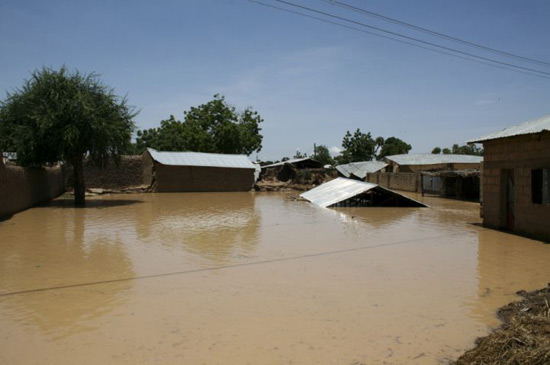MSF is surveying the impact and distributing relief items to people displaced by floods that overwhelmed a dam on the Rima River.

Nigeria 2010 © Chris Houston/MSF
Homes submerged by the flooding in Sokoto State.
More than 100,000 people have been forced to leave their homes due to flooding in northwestern Nigeria after a dam failed on the Rima River near the town of Goronyo, in Sokoto State, on September 8. Dozens of villages were submerged when a large section of the Goronyo dam’s spillway collapsed in the midst of this year’s rainy season, one of the wettest on record.
In the affected villages, people have been struggling to hold back the rising waters with sandbags. Thousands of mud-brick houses have been destroyed by the flood. Homeless people are living under improvised shelters of plastic sheeting and sticks, on whatever dry ground they can find. The fortunate are finding refuge with neighbors and families.
Others are fleeing to higher ground, wading through floodwaters that are chest-deep in places with their belongings balanced on their heads. At a secondary school in Goronyo, thousands of people have sought shelter for themselves and their livestock. Conditions are cramped and unsanitary. People don’t know when they will be able to return to their villages, to salvage what is left of their homes and try to rebuild their lives.
In addition to losing their homes and possessions, many families have seen their crops completely wiped out and their stores of food ruined. In an area where people depend on subsistence agriculture, this represents a complete loss of livelihood. For these families, finding sufficient food will be a major concern in the coming months.
Following initial flooding on September 1, MSF distributed blankets and mosquito nets to thousands of displaced people and installed a water distribution system. In the coming days, MSF will conduct a larger distribution, delivering supplies–including tarpaulins, blankets, mosquito nets, and soap– for up to 60,000 people, along with 600,000 liters per day of clean water.
MSF continues to survey the area to gauge the full extent and numbers of people affected by the flooding. Villages as far as 200 kilometers (120 miles) from the dam have been impacted. “It’s difficult to make an accurate assessment,” said MSF project coordinator Chris Houston, “because the roads are cut off and we’re relying essentially on word of mouth.”




